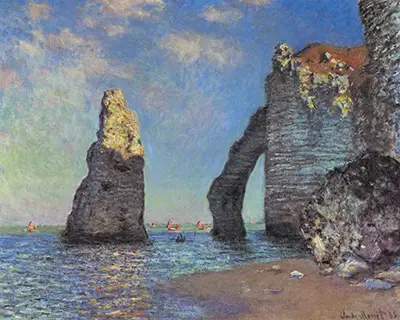The work is one of many undertaken by Claude Monet of this stretch of the Normandy coastline and depicts the well-known white chalkstone cliffs, one of three natural arches and the tall rock pillar known as L’aiguille or the needle.
The rock formations carved by the power of the sea through the ages meant the area was famed for its spectacular natural beauty and as such was very popular with tourists, writers and artists.
Monet was familiar with the work of other painters who had come before him, especially Eugene Delacroix and Gustave Courbet, the latter in particular was very influential to many of the impressionist painters including Monet. Courbet painted several scenes in the area, and it is thought Monet had one of his watercolours of the cliffs in his possession.
The magnificent scenery of the region meant the area was frequently very busy with tourists and sightseers which could, on occasion, be difficult for an artist needing to work undisturbed.
This painting, The Cliffs at Etretat, was undertaken from a position on the shore which was not easily accessible; Monet had to either row to the beach on a boat or use a steep and difficult path and in this way, he could work in relative peace and quiet, away from the crowds and onlookers.
As with many of his subjects, Monet painted a series of works depicting the same scene, sometimes from the same viewing point, sometimes from a different angle or perspective. His aim was to capture the essence of the subject in differing atmospheric conditions, times of day and throughout the changing seasons. This continued with Water lilies, Haystacks and Rouen Cathedral.
He would often work on several canvases at once, changing between paintings according to the conditions at the time, usually painting quickly to capture the scene before the conditions altered. Some works capture the passage of time so well that it is possible to determine the time of day by the quality and position of the sunlight.
The version of The Cliffs at Etretat painted here appears to show the landscape as the sun is beginning to set, the golden light falling on the upper half of the rock tower and just picking out the outer edge of the top of the cliff.
The evening sunlight is also picked out in the sea and his use of quickly applied brushstrokes and swabs of paint creates dynamic movement in the waves. Monet’s use of colour highlights the glittering sparkle of the sun on the water and gives a sense of depth to the undulating sea.
The composition of this piece incorporates the strong vertical lines of the rock formations which emphasises the dramatic strength and solidity of the landscape. These rock formations were huge and overpowering and their presence dominated the coastline. The Cliffs at Etretat is an excellent example of Monet’s exceptional skill in capturing the essence of the landscape in all its natural glory.


